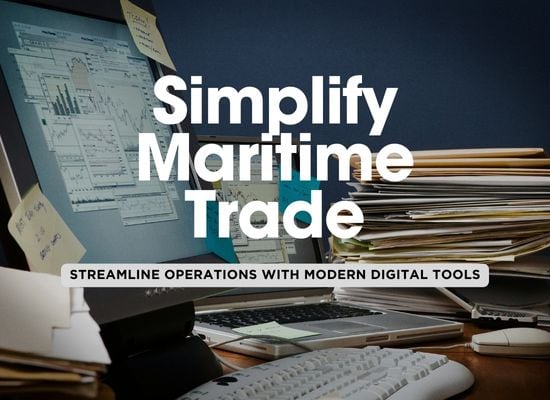10 Proven Ways to Eliminate Administrative Burdens in Maritime Trade

The maritime trade industry faces unique challenges when it comes to managing administrative tasks. From unpaid invoices to complex fee settlements, these hurdles can slow down operations and inflate costs. However, with the rise of digital platforms and innovative tools, shippers, brokers, and carriers now have powerful solutions to streamline their workflows. Whether it's automating invoices or leveraging escrow services, here are 10 ways to eliminate administrative burdens and keep your maritime business sailing smoothly.

1. 🚢 Optimize Shipping Routes with AI-Driven Navigation
Why It Matters: Inefficient routing not only increases fuel costs but also adds administrative complexity due to delays and rescheduling. AI-driven navigation tools analyze real-time data, including weather patterns and port congestion, to create the most efficient shipping routes.
How to Implement: Leverage tools like Windward or Nautilus Labs that offer AI-powered solutions for route optimization. These platforms integrate with onboard systems to adjust routes dynamically, minimizing delays and administrative headaches.
Key Benefits:
- Fuel Savings: Reduced fuel consumption by avoiding unnecessary detours.
- Reduced Downtime: Ships spend less time idle at congested ports.
- Simplified Logistics: Fewer manual adjustments to shipping schedules.
Insights:
Faster Deliveries: Average shipping times are reduced by 20%, improving client satisfaction.
Cost Savings: Companies save up to 15% on fuel costs by using AI-driven route optimization.
2. 🧾 Automate Invoice Processing
Why It Matters: Manual invoice handling is a time sink, prone to errors and delays. Automating this process ensures accuracy, faster payments, and easier tracking of outstanding balances.
How to Implement: Use software designed for the maritime industry to digitize invoices, integrate them with accounting systems, and send automated reminders for unpaid balances. Pairing tools like Mercurion’s payment system with your internal invoicing software can make the entire process frictionless.
Key Benefits:
- Accuracy: Minimizes human error and discrepancies.
- Efficiency: Automates reminders, so unpaid invoices don’t slip through the cracks.
- Transparency: Real-time tracking keeps all parties informed.
Insights:
- Error Reduction: Companies report a 60% drop in billing errors after automating invoicing.
- Admin Time Saved: Staff can reclaim 4-6 hours per week, focusing on high-value tasks.
3. 💻 Integrate Platforms for Unified Operations
Why It Matters: Disconnected systems create inefficiencies, leading to duplicated efforts and missed opportunities. Integrating platforms allows you to centralize operations, improve data flow, and streamline administrative tasks.
How to Implement: Tools like Shipnext offer powerful integrations that pair seamlessly with Mercurion’s escrow services, enabling you to manage freight, fees, and settlements all in one place. By unifying these processes, you eliminate redundant workflows and create a more cohesive operational framework.
Key Benefits:
- Simplicity: A single source of truth for all trade-related data.
- Scalability: Integrated systems can handle increased volumes without additional admin workload.
- Collaboration: Enhances communication between shippers, brokers, and carriers.
Insights:
- Efficiency Boost: Companies see up to a 35% increase in operational efficiency after adopting unified platforms.
- Cost Savings: Integration reduces system maintenance costs by 10-15%.
4. 🖊️ Adopt E-Signature Tools for Contract Management
Why It Matters: Paper contracts and manual signing processes slow down operations, especially when dealing with multiple stakeholders across the globe. E-signature tools simplify this process, ensuring faster approvals and fewer delays.
How to Implement: Platforms like DocuSign or Adobe Sign can digitize the entire contract process. Integrate these tools with your shipping and escrow systems for a seamless workflow. This ensures contracts are signed, stored, and referenced without ever leaving your digital environment.
Key Benefits:
- Speed: Reduces the time to finalize agreements, enabling quicker actions.
- Accessibility: Stakeholders can sign documents from anywhere in the world.
- Compliance: E-signature tools provide audit trails for regulatory purposes.
Insights:
- Time Saved: Average contract turnaround drops from 2-3 weeks to under 48 hours.
- Error Reduction: E-signatures reduce the risk of incomplete or unsigned contracts by 50%.
5. 🤖 Leverage AI for Predictive Maintenance Scheduling
Why It Matters: Maintenance-related admin work can overwhelm maritime operators, especially when unexpected breakdowns occur. AI-powered tools can predict maintenance needs before issues arise, helping to streamline workflows and reduce downtime.
How to Implement: Adopt predictive maintenance software that uses AI to analyze equipment performance. Pair it with digital platforms like Shipnext to align maintenance schedules with freight operations, minimizing disruptions.
Key Benefits:
- Proactive Management: Reduces reactive maintenance and last-minute administrative scrambling.
- Cost Efficiency: Prevents costly breakdowns and reduces unnecessary repairs.
- Improved Uptime: Keeps ships operational with minimal admin oversight.
Insights:
- Downtime Reduction: Predictive maintenance lowers downtime by 30-40%.
- Cost Savings: Companies save up to 25% on maintenance costs with AI-driven insights.
6. 💼 Outsource Non-Core Tasks
Why It Matters: Many administrative burdens come from tasks that aren’t central to your operations, such as payroll processing, legal compliance, or routine documentation. Outsourcing these tasks frees up internal resources for more strategic work.
How to Implement: Partner with maritime-specific service providers to handle these non-core tasks. For instance, outsource compliance documentation to firms experienced in maritime regulations or administrative work to virtual assistants familiar with the industry.
Key Benefits:
- Focus: Allows your team to prioritize mission-critical tasks.
- Flexibility: Scales with your business needs without increasing internal headcount.
- Specialization: Outsourcing partners often provide better expertise in their niches.
Insights:
- Productivity Gains: Teams report a 20% boost in productivity after outsourcing routine tasks.
- Cost Savings: Businesses save an average of 18% on operational costs by outsourcing non-core activities.
7. 🗨️ Centralize Communication with Collaboration Tools
Why It Matters: Communication breakdowns between departments or external partners can lead to missed deadlines and duplicate efforts. Centralized collaboration tools ensure everyone stays on the same page, reducing administrative headaches.
How to Implement: Utilize platforms like Slack, Microsoft Teams, or maritime-specific tools to streamline communication across teams. Integrate these tools with systems like Shipnext to keep updates on freight, settlements, and logistics in one accessible location.
Key Benefits:
- Transparency: Everyone has access to the same information, reducing confusion.
- Efficiency: Speeds up decision-making with real-time updates.
- Teamwork: Enhances collaboration between internal teams and external stakeholders.
Insights:
- Response Time Improvement: Businesses see a 30% reduction in response delays with centralized communication tools.
- Error Reduction: Miscommunication errors drop by 40% after implementing such tools.
8. 🔒 Use Blockchain for Document Security
Why It Matters: In the maritime industry, sensitive documents like bills of lading, contracts, and compliance certifications can be vulnerable to tampering or loss. Blockchain technology secures these documents, ensuring they are accessible, verified, and immutable.
How to Implement: Integrate blockchain-based solutions to store and share documents securely. Platforms like Mercurion can complement this by ensuring escrow funds and document security go hand in hand, giving shippers and carriers peace of mind.
Key Benefits:
- Security: Prevents unauthorized access or document alterations.
- Traceability: Provides a clear audit trail for compliance and legal purposes.
- Convenience: Eliminates the need for physical document storage and retrieval.
Insights:
- Compliance Risk Reduction: Blockchain reduces compliance risks by 50%.
- Time Savings: Document verification times drop from days to minutes.
9. 💰 Implement Cost-Sharing Models for Efficiency
Why It Matters: Administrative burdens often increase when companies shoulder the entire cost of processes like freight settlement, compliance checks, or invoicing. Cost-sharing models distribute these expenses among multiple parties, reducing the strain on any one entity.
How to Implement: Negotiate cost-sharing agreements with your partners or utilize platforms like Mercurion, which allow fees to be split transparently between buyers and sellers. This ensures fair distribution and encourages collaboration.
Key Benefits:
- Fairness: Aligns incentives and responsibilities between all parties.
- Cost Reduction: Decreases individual financial burdens for operational processes.
- Transparency: Provides clear breakdowns of who pays for what.
Bold Insights:
- Cost Savings: Companies reduce administrative costs by 10-15% with effective cost-sharing.
- Enhanced Collaboration: Encourages stronger partnerships through shared responsibility.
10. 🎓 Train Staff in Digital Competencies
Why It Matters: Even with advanced tools, a lack of digital literacy can create bottlenecks. Training your staff to effectively use platforms like Shipnext and Mercurion ensures you maximize the value of these systems while reducing manual errors.
How to Implement: Invest in regular training sessions tailored to maritime-specific digital tools. Provide resources like user guides, webinars, and one-on-one coaching to make staff comfortable with new technologies.
Key Benefits:
- Empowerment: Staff feel more confident and productive.
- Efficiency: Reduces reliance on external support for troubleshooting.
- Future-Ready: Prepares your workforce for upcoming technological advancements.
Insights:
- Error Reduction: Digital training can reduce admin errors by 40%.
- Productivity Boost: Companies report a 20% improvement in workflow efficiency post-training.
Reducing administrative burdens in maritime trade is no longer a distant dream—it’s achievable with the right strategies and tools. These methods can revolutionize your operations. By streamlining processes, enhancing communication, and investing in staff training, you’ll not only save time and money but also position your business for long-term success in an ever-evolving industry.
Table Summary
| ShipUniverse: 10 Ways to Eliminate Administrative Burdens in Maritime Trade | ||
|---|---|---|
| Strategy | How It Helps | Key Insights |
| Optimize Shipping Routes with AI-Driven Navigation | AI-powered tools like Nautilus Labs optimize routes by analyzing real-time data, reducing fuel costs and delays. | Fuel costs decrease by 15%, and shipping times improve by 20% with optimized routing. |
| Automate Invoice Processing | Digital invoicing tools minimize manual errors, send automated reminders, and ensure timely payments. | Billing errors drop by 60%, and staff regain 4-6 hours weekly for other tasks. |
| Integrate Platforms for Unified Operations | Combining tools like Shipnext and Mercurion streamlines data flow, reducing redundant workflows. | Operational efficiency increases by 35%, and system maintenance costs drop by 10-15%. |
| Adopt E-Signature Tools for Contract Management | Platforms like DocuSign reduce delays by enabling contracts to be signed and stored digitally. | Contract turnaround drops from 2-3 weeks to under 48 hours, and incomplete contracts are reduced by 50%. |
| Leverage AI for Predictive Maintenance Scheduling | AI tools analyze performance data to predict when maintenance is needed, reducing downtime. | Downtime is reduced by 30-40%, and maintenance costs decrease by 25%. |
| Outsource Non-Core Tasks | Hiring external experts for routine tasks like payroll or compliance allows teams to focus on strategic work. | Productivity increases by 20%, and operational costs drop by 18%. |
| Centralize Communication with Collaboration Tools | Tools like Slack or Teams consolidate communication, reducing delays and errors caused by fragmented updates. | Response times improve by 30%, and miscommunication errors drop by 40%. |
| Use Blockchain for Document Security | Blockchain ensures documents like bills of lading are tamper-proof and easily verifiable. | Compliance risks decrease by 50%, and verification times drop from days to minutes. |
| Implement Cost-Sharing Models for Efficiency | Distributing costs for processes like compliance and settlements reduces the financial burden on individual parties. | Admin costs decrease by 10-15%, and collaboration improves through shared responsibility. |
| Train Staff in Digital Competencies | Providing training in tools like Shipnext and Mercurion ensures staff can use technology effectively, reducing errors. | Admin errors decrease by 40%, and workflow efficiency improves by 20%. |

Do you have a Maritime Product or Service that may be of interest to Shipowners? Tell us about it here!
Do you have feedback or insights? Please reach out to editor @ shipuniverse.com



